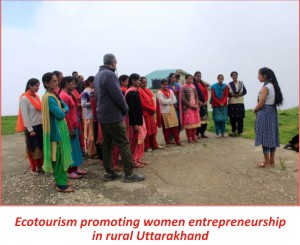|
Ecotourism - A Way of Holistic There is no dearth of natural beauty in India starting from the great Himalayas in the North, river systems of central India, vast ocean stretches, beautiful ghats, valleys, deserts and forests. Lot of these places have been developed as important tourism centres by the hospitality industry. The Himalayan states receive more than 700,000 tourists every year for commercial and pilgrimage tourism. This growth in traditional tourism has resulted in over exploitation of natural resources coupled with unsystematic development and environmental pollution seen in the form of huge plastic footprint left by tourists.
Nielsen report of 2016 ‘Adventure Tourism
Market Study in India’ prepared for
The Indian Himalayan states thus have to grapple with unchecked tourist influx, low job opportunities for the local community and poor waste management in and around the city and popular trek routes as well. Eco-tourism can play an important role in addressing these issues. The word ecotourism means responsible tourism and more specifically tourism which leaves minimum impact on nature. There are still many unexplored areas in India which could be developed as eco-tourism spots and they can contribute significantly in the economic development of local communities. Ecotourism can be used to promote women and youth entrepreneurship in rural areas, thereby addressing issues of job creation in these areas. The traditional cuisines, traditional agriculture are mostly known by the women of a particular area. However, their contribution is not acknowledged since their services are not yet monetised. Eco tourism can help by converting the daily activities of women into income generating ventures. They can offer hospitality to the tourists by providing traditional food, offering homestays in their houses, helping them to learn local agriculture practices. Local youth can become eco-guides and introduce local flora, fauna, medicinal plants to the tourists. Becoming trek guides is another activity where local youth can find their livelihoods instead of migrating to cities. Thus, ecotourism can play an important role in the holistic and sustainable development of rural areas by promoting the local food, culture, language, handicrafts, sports, indigenous knowledge, medicines as well as generating livelihoods across sectors, gender, caste and age. The tourism sector is expected to grow at an unprecedented rate with an average annual rate of 7.9% from 2013 to 2023. It is expected that the Indian Himalayan Region will receive 240 million tourists by 2025 (Dr. Vikram Singh Gaur August, 2018)2. It is thus crucial to intensify the reach of ecotourism in the Himalayan states to promote responsible tourism. ■
Reference:
Gitika Goswami
|
 Ministry
of Tourism, states that trekking is the most practiced landbased
adventure activity in the north zone states, especially Himachal Pradesh
and Uttarakhand. The report also states that Himachal Pradesh and
Uttarakhand have maximum number of unorganised adventure tour operators
- around 334 and 135 respectively. Popular trek routes Kheerganga and
Triund and other such commercial treks have become a party ground for
many young tourists coming from the neighbouring states who have filled
the trek routes with heaps of plastic water bottles and plastic packages
of commercially available food items in the villages. The commercial
tourist hotspots in the hills have also witnessed rapid unchecked
construction of tourism infrastructure. The two Himalayan states in
north India have paid a heavy price in terms of loss of life and
property during natural disasters partly due to unchecked construction
for tourism. The situation is tense in other mountain states as well in
terms of socio-economic scenario. Sikkim is facing a huge challenge of
low job opportunities for the local communities. The data suggests that
70% of the jobs are taken up by outsiders leaving the local people
deprived of opportunities within their own state.
Ministry
of Tourism, states that trekking is the most practiced landbased
adventure activity in the north zone states, especially Himachal Pradesh
and Uttarakhand. The report also states that Himachal Pradesh and
Uttarakhand have maximum number of unorganised adventure tour operators
- around 334 and 135 respectively. Popular trek routes Kheerganga and
Triund and other such commercial treks have become a party ground for
many young tourists coming from the neighbouring states who have filled
the trek routes with heaps of plastic water bottles and plastic packages
of commercially available food items in the villages. The commercial
tourist hotspots in the hills have also witnessed rapid unchecked
construction of tourism infrastructure. The two Himalayan states in
north India have paid a heavy price in terms of loss of life and
property during natural disasters partly due to unchecked construction
for tourism. The situation is tense in other mountain states as well in
terms of socio-economic scenario. Sikkim is facing a huge challenge of
low job opportunities for the local communities. The data suggests that
70% of the jobs are taken up by outsiders leaving the local people
deprived of opportunities within their own state.